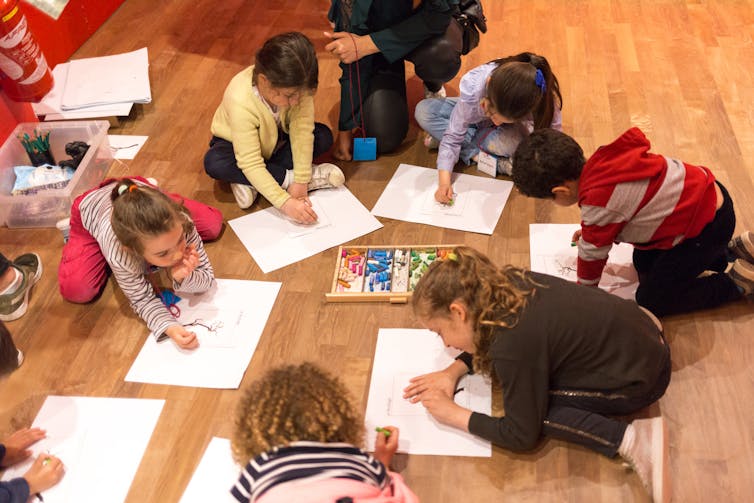
In our house we have a favourite story about the time our toddler was dragged from the National Portrait Gallery kicking and screaming “I want to see more paintings!!!”
She needed lunch, we had to go, but she really loved the “Nick Cave Gallery”, as she called it, with his luminous portrait by Howard Arkley on display.
What parenting miracle did we pull off to have a daughter that loves art galleries so much? We have always taken our kids to galleries. It’s what we do for fun and is what they want to do as teenagers. Visiting a new town or city, we check out local art wherever we can find it.
I have a long history of working with galleries and I am a practising artist, so gallery spaces are familiar to us and are meaningful places associated with joy, wonder and celebration. But you don’t need to be an artist to help your kids enjoy a gallery visit.
Read more: Four tips to make the most of your next gallery visit
Start young
Children are naturally curious, so start young and make gallery visits a normal activity.
Expose babies to art as soon as possible: research proves regular engagement with art develops children’s aesthetic sensibilities and even very young children can respond to art in complex ways.

I remember my baby son neighing like a horse in front of a painting before he could talk. I looked at the painting he was staring at, Nicholas Harding’s Bob’s daily swim. There in the thick, painterly background, was a horse. My son connected with the work because he loved horses.
Before your visit
Look for ways to introduce your child to artists before your visit. Art activities bring exhibits to life in fun and engaging ways.
For example, from the NGA you can make Sol Le Witt-inspired vegemite toast. Suddenly, Wall drawing no.380 a-d (1982) takes on a whole new flavour, and your child is connected with the work before they see it.
Try to tap into your child’s interests. If they like superheroes, pop icons or Hollywood stars they might just love to see a show by Yankunytjatjara artist Kaylene Whiskey.
Marilyn JS Goodman’s brilliant book Children Draw includes tips on taking your child to a gallery: consider going on a weekday when it’s less crowded, include the cafe, and, importantly, don’t try to see everything – for younger children plan on spending no more than an hour and don’t try to look at too many art works.

Let your child take the lead and include them in the planning. Planning a trip together may be the perfect time to ask questions and share knowledge: “did you know we can’t touch artwork in galleries? Do you know why?”
This can not only help avoid awkward situations with security guards but also helps your child to understand why we don’t touch art (we need to protect the artworks), and may encourage further inquiry into the art or gallery.
There’s no right or wrong response
Some adults may feel uncomfortable talking about art. Just try having a conversation about what you see, and be prepared to be amazed by what your child observes.
Start by asking your child questions: what are you noticing about this exhibition? What stories are these works telling? What do you think about when you look at this artwork?

In schools, you might hear teachers use thinking routines: what do you see? What do you think about that? What does it make you wonder? This stimulates curiosity and encourages students to make careful observations and thoughtful interpretations.
Some galleries use Visual Thinking Strategies, which also consists of three questions: what’s going on in this picture? What makes you say that? What else can we find?
You don’t have to like what you see. This can even be a great stimulus for discussions with your child: does art have to be beautiful to be good? Why do people make art? What was that exhibition about?
Interact with the art
You are allowed to take pencil and paper into most galleries and drawing is a great way of looking and slowing down your experience.
Most galleries have seating where you can sit and draw. Try taking a sketchbook for you and one for your child. Role model drawing, taking your time. You are not aiming to make a masterpiece but to use drawing to map out what you see.
Compare drawings and swap notes. Ask your child what they noticed and share what you found.
Another fun game in a gallery is to pose like the sculptures and paintings.
Most galleries offer programs for children and families. By attending tours you can pick up excellent tips from the educators who are experts at engaging children. They use simple and effective methods such as rolling a piece of paper up into a telescope to look at a work.

Some galleries also have children’s trails especially designed for engaging children. And if they don’t, you can make things up like how many trees can you see? Or can you find any animals in this exhibition?
After the visit
In a previous article I talked about extending your child’s experience after a gallery visit and how a comic my son made gave me an insight into his feeling about what he had seen at the gallery.
Make it a special day out together. At the end of the day you want your child to enjoy the experience and foster a love of art.
Read more: Holiday help! An art expert suggests screen-free things to do in every room of the house
Naomi Zouwer does not work for, consult, own shares in or receive funding from any company or organisation that would benefit from this article, and has disclosed no relevant affiliations beyond their academic appointment.
This article was originally published on The Conversation. Read the original article.







